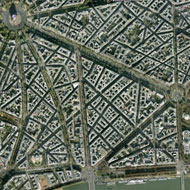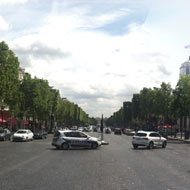Background
The Champs Elysees is the thoroughfare that runs through the heart of Paris and links the southeast to the northwest of Paris. It is a 1.2-mile long and 230-foot wide major road that runs from Place de la Concorde to Arc de Triomphe (Paris Digest). The avenue consists of two different sectors: the intensely developed northern part, from the Rond-Point to the Place de I’Etoile, and the well-landscaped southern part, from the Place de la Concorde to the Rond-Point. This grand boulevard has approximately 70-foot wide sidewalks (which sometimes include 22-foot wide access roads) and double rows of street trees to buffer pedestrians from traffic. But crossing 10 travel lanes (approximately 87 feet) is challenging for pedestrians. The average daily traffic volume is about 84,000, with an average of 10.67 accidents per year per intersection (Jacobs1994).
Because of its proximity to several Paris landmarks such as the Arc de Triomphe, the Champs Elysees has been a venue for several famous military parades and public events. On Bastille Day, the largest military parade in Europe passes down the Champs Elysees. Each year from the end of November to end of December, the Champs Elysees Committee contributes to the lighting of the Champs Elysees for the holiday season.
Adopted from: History of Avenue des Champs Elysees
The Champs Elysees originally consisted of market gardens, fields and swamplands on the outskirts of Paris. In 1616, Marie de Medici, a queen consort of France, decided to extend the garden axis of the Palais des Tuileries (a royal palace in Paris) with an avenue of horse-chestnut trees. In 1724, the Tuileries garden axis and the avenue were extended, leading beyond the Place de l'Etoile. By the late 1700s, the Champs Elysees had become a fashionable avenue and the trees on either side had thickened. In 1828, the Avenue des Champs Elysees became city property, and sidewalks, fountains and street lighting were added. By the 1860s, when Baron Georges Eugene Haussmann was giving Paris its present shape, the Champs Elysees had become a center of cafes, hotels and luxurious homes. However, the prosperity of the 1960s attracted airline companies, car dealerships, fast-food restaurants, panhandlers and badly parked cars. Rents plummeted and many commercial spaces stayed empty.
Adopted from: Riding 1990
In 1990, Jacques Chirac, the mayor of Paris, began a $45 million project to redevelop the historic zones and public spaces. According to Barbe, the aim of the redevelopment was to “renew a grand promenade popular with Parisians, the French people and foreigners by once again giving it an urban quality, a dignity and a life which it had lost (Barbe 1995).”
The main elements of the redevelopment of Champs Elysees included (Pearce 1998):
- Enhancing the perspective of the avenue by removing curbside car-parking and creating a new 850-space underground car park.
- Widening the sidewalks.
- Planting a second row of trees.
- Reducing and realigning the street furniture, such as streetlamps and bus stops.
- Upgrading the shop frontages by new regulations governing publicity, signs and terraces.
- Changing the land use zoning (plan d’occupation des sols) to encourage the return and development of such functions as hotels and cinemas that generate some of the activity for which the avenue was previously known.
What Makes Champs Elysees a Great Place?
Comfort and Image
- Extra-wide sidewalks provide adequate space for cafes and vending.
- Continuity of trees and lighting scales down the expanse of the sidewalk.
- The alley of trees along the curb buffer pedestrians from the automobile traffic.
- There are few benches on the Champs Elysees, but many restaurants and cafes provide outdoor seating.
- Plantings, coverings and shade enhance outdoor seating experiences.
- Sidewalk amenities include colorful banners, cast-iron kiosks with displays, ornate street lamps and interesting sidewalk patterns.
Uses and Activities
- Most people walk on the sunny northside, where there are more cafes, theaters, chain stores and boutiques.
- Fewer stroll on the south, where there is less sun and more banks and luxury restaurants.
- Activity does not decline after dark; the street is well-lit and takes on a new ambiance of nightlife.
Adopted from: Project for Public Spaces
Shopping and Tourism
The Champs Elysees is a great 30-minute walk from Champs Elysees Clemenceau metro station (line 1) to Arc de Triomphe and Charles de Gaulle metro station (line 1). It is also the top Paris shopping district with 500,000 visitors daily. Many famous French and international brands have their flagship stores along the corridor. There are luxury shops and hotels, such as Cartier, opened in 2003, Louis Vuitton’s five-story flagship store, and the Fouquet’s Barrière hotel, where the least expensive room is nearly $900 a night. Louis Vuitton is so popular that its customers — most of them tourists — often line up outside for entry (Sciolino 2007).
The Champs Elysees is one of the most expensive avenues in the world, and this causes a loss of small, local stores in the area. With rents as high as $1.2 million a year for 1,000 square feet of space, the Champs Elysees is the most expensive strip of real estate in Europe, and the third most expensive in the world after Fifth Avenue in New York and Causeway Bay in Hong Kong (Sciolino 2007). As such, only global chain stores can afford the rent, and most of the music clubs and movie theaters are closing. The avenue progressively is losing its exceptional and symbolic character, thus its attractiveness. The City tries to push back by stopping the opening of international stores and providing annual subsidies for old, local businesses. For example, the H&M clothing chain was not permitted to open a store on the Champs Elysees in 2007.
Lessons Learned
Potential Benefits:
- Increases the city’s tourism industry.
- Enhances the pedestrian experience. The double rows of trees, widened sidewalks, outdoor seating and cafes on the sidewalk contribute to memorable walking experience.
- Provides for safe nightlife. The street is well-lit and creates a new ambiance of nightlife.
Potential Issues:
- High rents: The continued success of the street has led to high rents, which is causing the loss of its small businesses and thus the street’s original identity.
- Maintenance: The street requires constant maintenance to keep the corridor safe and clean. Police officers and street cleaners keep eyes on the street to make it safer for its visitors and compensate for a lack of trash cans.
- Street crossing: Crossing wide, heavy trafficked roads is challenging for pedestrians.
- Shade vs. visibility: The London plane trees, spaced at about 30 feet, were pruned too high above ground level, and thus do not provide appropriate shade and visual protection from the traffic. However, they do allow greater visibility of businesses.
- Pedestrian access: The outdoor dining and kiosks on the sidewalk sometimes block the pedestrian flow.
Sources
Barbe, C., 1995. “La Rehabilitation des Champs Elysees (mimeo).” Paris: Direction de l’Amenagement Urbain
History of Avenue des Champs Elysees (http://www.placesinfrance.com/history_des_champs-elysees.html)
Jacobs, Allan B. et al., 1994. “Boulevards: A Study of Safety, Behavior, and Usefulness” Working paper. UCTC No. 248,
Paris Digest, “Champs Elysees Facts”(http://www.parisdigest.com/promenade/champselysees.htm)
Pearce, Douglas G., April 1998. “Tourism development in Paris: Public intervention” Annals of Tourism Research, Volume 25, Issue 2,Pages 457-476
Project for Public Spaces (http://www.pps.org/great_public_spaces/one?public_place_id=105)
Riding, Alan,1990. The New York Times (http://articles.sun-sentinel.com/1990-01-23/news/9001200676_1_champs-elysees-champs-elysees-fast-food-restaurant).
Sciolino, Elaine, Jan. 31, 2007. “Megastores March Up Avenue, and Paris Takes to Barricades,” The New York Times (http://www.nytimes.com/2007/01/31/world/europe/31paris.html?pagewanted=all)
Photo Sources
MIG, Inc.


